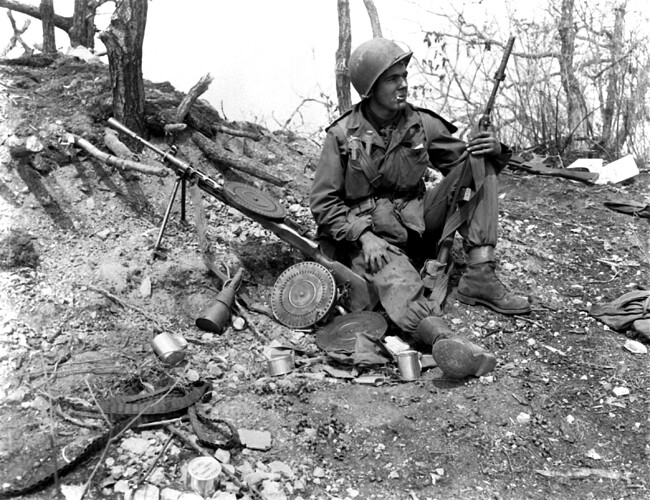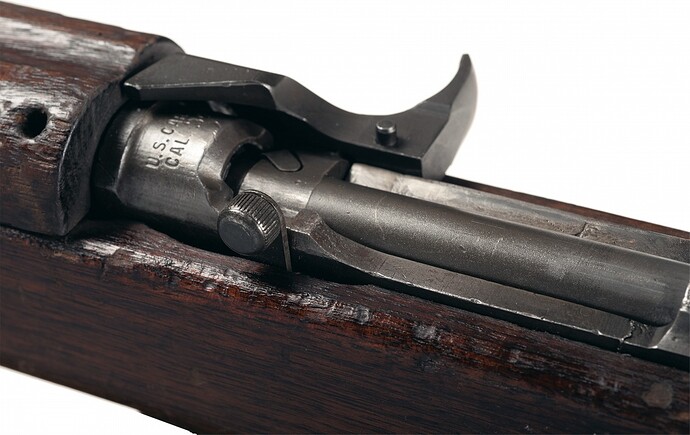Externally, there is little to identify the M-2 from the M-1, aside from the add-on Bayonet lug added by the end of WW II,no specific date mentioned which might be found on either version, only the selector switch truly decides the matter. The Switch is on the left side of the Receiver, near the front ring (where the barrel screws in) The magazines were usable in either version, 15 or 30 round. The rate of fire was sufficient to suppress the enemy, and over all, it was a good weapon. The only drawbacks were that with its not too powerful cartridge, effective range was limited to under 300 yards. This mostly due to the very light bullet used (.2 ounces)in a very light, essentially a Pistol cartridge. This would be aggravated in the freezing Winter weather, shortening the range even further.
Here is a cut&paste from an article in the American Rifleman magazine," Arms of the Chosin Few" (by Bruce Canfield, 2010) and speaks of the M-2 (and M-1) used in Korea. The attached image shows the selector switch of the M-2. Don’t know if this will answer your questions very well, but it’s something.
"U.S .30 Caliber Carbine
Of all the primary U.S. small arms of the era, the M2 carbine proved to be the most problematic during the fighting at Chosin. The carbine was adopted in late 1941 to replace the pistol in the hands of officers and other personnel whose primary duties precluded carrying the standard M1 Garand service rifle. The trim little semi-automatic carbine was much lighter and compact than the Garand (approximately 5 pounds vs. 9½ pounds) and used a 15- or 30-round detachable box magazine, as opposed to the M1 rifle’s eight-round en-bloc clip. To achieve this weight reduction, the carbine fired a .30-cal. cartridge that was much less powerful than the .30-’06 Sprg. cartridge fired by the M1 rifle. Since the carbine was originally intended to replace the .45 pistol, the reduced range, accuracy and “stopping power” were not considered detrimental. During World War II, however, the carbine was often used in place of a full-power service rifle (something it was not designed to do), and the carbine’s deficiencies when used in this manner soon became evident.
To increase the carbine’s firepower, a selective-fire version of the .30-cal. M1 carbine was adopted as the “M2” carbine and first issued in late World War II. During the post-war period, many standard M1 carbines were converted to M2 configuration by means of a simple kit. By the time of the Korean War in 1950, the M2 was the predominate version of the carbine in service, and many soldiers and Marines carried it in lieu of the heavier, but more effective, M1 rifle. Throughout much of the Korean War in general, and the Chosin campaign in particular, the carbine was often looked upon with disfavor for its failure to provide adequate “stopping power” and for the frequency of its malfunctions in inclement weather.
A 1st lieutenant in the 1st Marines, Joseph Fisher, made the following statement regarding the carbines in his unit during the Chosin fighting: “About 30 percent of our carbines gave us trouble; some wouldn’t fire at all [and] others responded sluggishly. But the main reason my men lost confidence in the carbine was because they would put a bullet right in a Chi-Com’s chest at 25 yards range, and he wouldn’t stop. This happened to me. The bullet struck home; the man simply winced and kept on coming. There were about half a dozen of my men who made this same complaint; some of them swore they had fired three or four times, hit the man each time, and still not stopped him.”
Such complaints were typical of those lodged against the M2 carbine in Korea. In some cases, the soldier or Marine may have believed he hit his target but actually missed and erroneously blamed the carbine. In other cases, if our troops had been armed with .45 pistols rather than carbines, one might wonder how many of the enemy would not have been touched at all. Other Marines held their carbines in higher esteem, but they were in the definite minority. In any event, it cannot be denied that the carbine did not perform up to expectations during the Chosin campaign. Despite its light weight and rapid-firing capability, the carbine was one of the more unpopular arms of the conflict due to the relative ineffectiveness of its cartridge and its propensity to malfunction under even marginal weather conditions."


